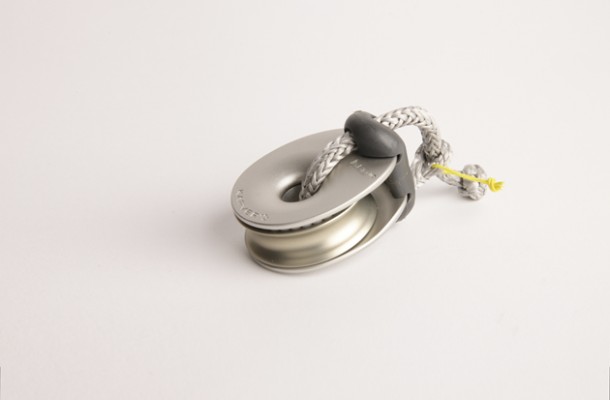Who’s it for? Sailors wanting to take weight and friction out of deck gear while increasing strength and ease of use. Tested by Ross Applebey
Karver KBO 10 lashing block
Lashing blocks offer weight-saving, good articulation, no metal-on-metal wear and high strength, so it’s no surprise they are becoming popular. This KBO block is elegant-looking with rounded edges to avoid chafing lines or dinging the deck.
It came with its own rope shackle, making fitting and unfitting the block very quick.
A plastic guide to secure the rope shackle was also fitted. This makes a permanent installation stable and reduces the risk of the block capsizing on itself – great for use as a halyard foot block or similar. However, if it is to be used as a snatch block, the guide is best removed to enable the block to be clipped over the middle of a line.
We used it on our Oyster Lightwave 48 as a multi-purpose snatch block, so I removed the guide and used lashings to keep the rope shackle attached. As an additional precaution we added a bungee tether, which also served to keep the block standing up when clipped onto the guardwires.
The block is designed for lines up to 12mm diameter, but without the plastic guide it handled 14mm rope without extra friction. The most demanding load we applied was the outboard jib sheet lead (in up to 30 knots), where the block looked a little small, but it performed perfectly and did not suffer any ill effects.
Despite the KBO 10 block weighing in well under 100 grams, it is no lightweight when it comes to load-handling.
We used the block for many other tasks, from spinnaker sheet tweaker (very handy when changing sheets) to mooring line deflector, to allowing halyards to be cross-winched, to spinnaker staysail lead block. It is extremely adaptable, quick to attach and remove.
The rope shackle supplied seemed thin, but it did cope with everything we threw at it. With any significant chafe this could become a weak link however. For a more permanent application, I would be tempted to use a Dyneema lashing (with several passes) to ensure security.
A nice feature of the design is that, even if the aluminium components were somehow to fail, the working line remains secure as the rope shackle is looped through the middle of the block and hence around the line. This could make the block much safer than conventional blocks in many situations.
Verdict
In summary, this is a reliable, easy to use, lightweight, adaptable block with many potential uses at a fair price.




